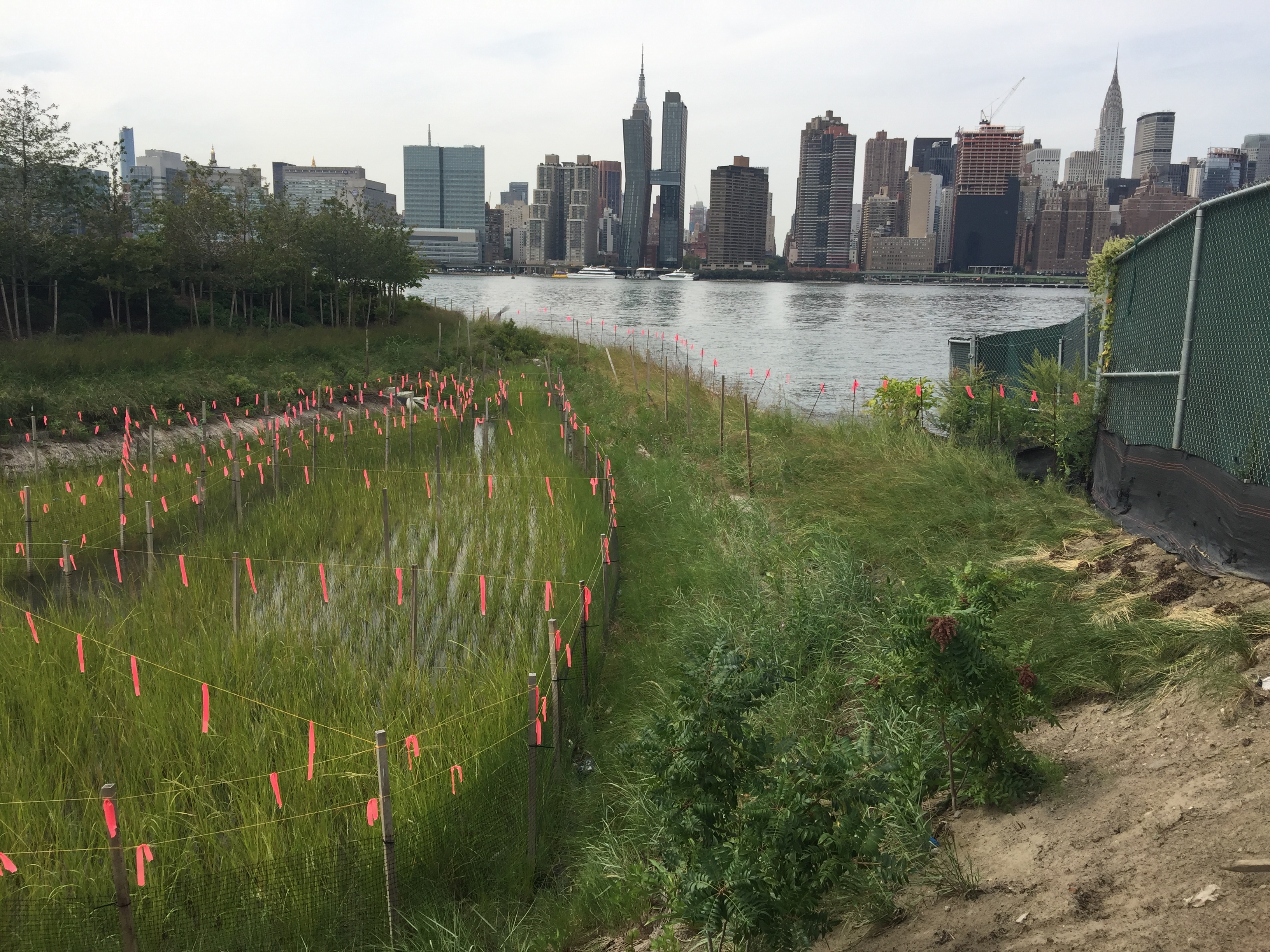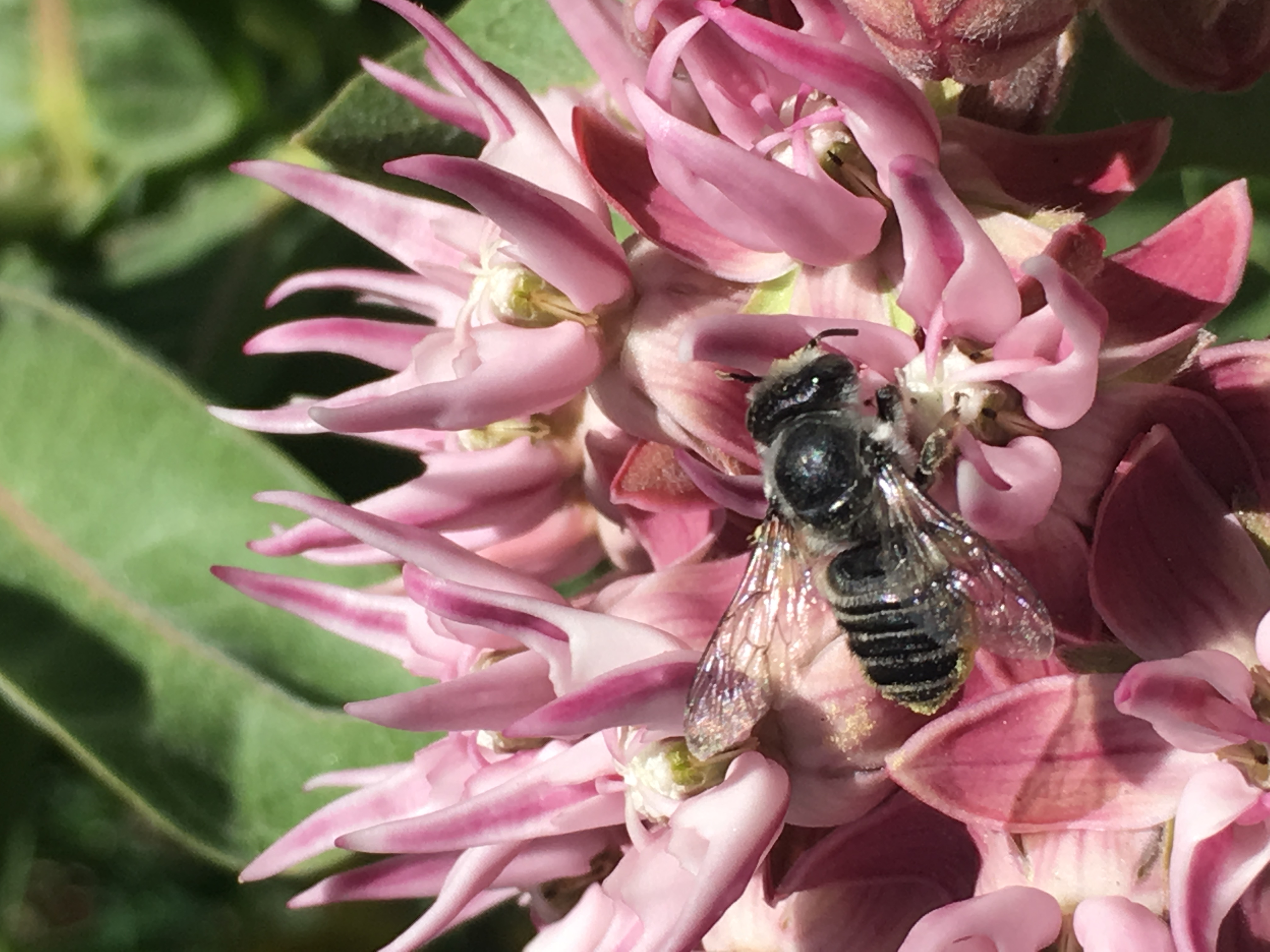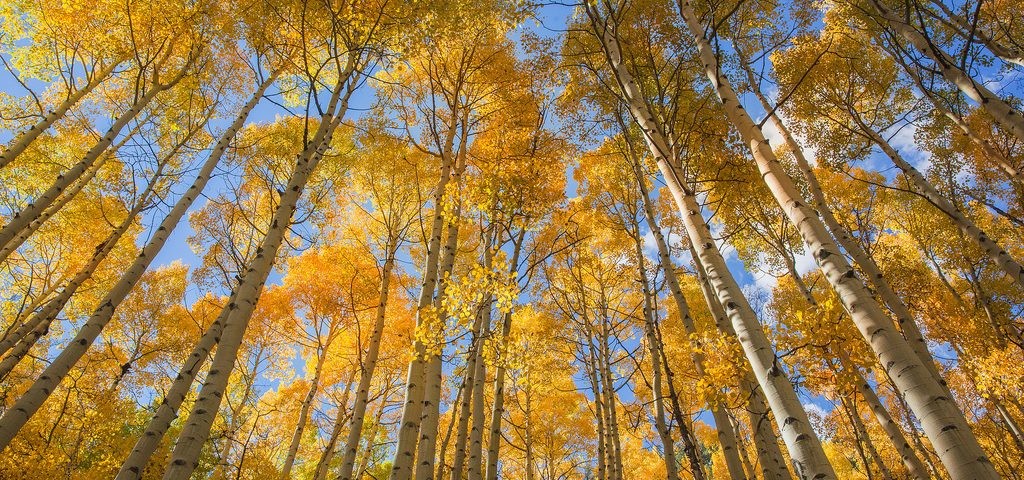
Seagrass, Seagrass, Who Do You See?
December 6, 2018
Hunter’s Point South Phase II – Best Urban Landscape Project
February 26, 2019by Liz Clift
On a recent trip, I was back in a familiar landscape where I know a number of the names of native plants—not just trees and flowers, but grasses as well. Being able to recognize these deepened my sense of temporarily returning home, and what it means to belong to a place.
The experience also led me to consider how an ecological vocabulary changes the way we see the world. Much like having a vocabulary around estuary English, having a vocabulary around one’s local ecological environments can add depth and texture to the world. A red-capped mushroom with charming white spots is no longer just a toadstool, or just warning that it’s poisonous. It’s suddenly likely Amanita muscaria (and culinary, if properly identified and prepared. That being said, please don’t eat foraged mushrooms unless you’re very certain in the ID.). Finding a good spot for morels (Morchella spp.) is an opportunity to become acquainted with that plant community—and the conditions that cause morels to fruit. The evergreen becomes a conifer becomes western red cedar (Thuja plicata), whose boughs have been used for medicinal purposes for longer than time can tell and which may have modern applications as a broad-spectrum anti-microbial.
Environmental biologist, botanist, and professor Robin Wall Kimmerer writes that an ecological vocabulary is more than just a base of knowledge. She argues that knowing the names of plants and animals turns them from objects into a part of our communities. She writes
“When I am in the woods with my students, teaching them the gifts of plants and how to call them by name, I try to be mindful of my language, to be bilingual between the lexicon of science and the grammar of animacy. Although they still have to learn scientific roles and Latin names, I hope I am also teaching them to know the world as a neighborhood of nonhuman residents, to know that, as ecotheologian Thomas Berry has written, ‘we must say of the universe that it is a communion of subjects, not a collection of objects.’”
However, we’re losing nature-words, words that describe our local ecologies all the time. In 2007, the Oxford children’s dictionary removed a number of nature-based words, including acorn, ash, beech, bluebell, buttercup, catkin, cygnet, dandelion, fern, hazel, heron, mistletoe, newt, pasture, and willow (along with a number of other words).
Maybe losing the word acorn from a children’s dictionary seems insignificant. However, it’s also a way to begin to erase a rich social and ecological history. Acorns not only come from, and produce, oak (Quercus spp. and Lithocarpus spp.) trees, they are also a source of food for a variety of animals (including humans). Acorns have been used to barter and for medicine. Acorns are so iconic that they’re frequently used to represent beginnings and potential. You can probably picture one right now.
But what if I asked you about something less familiar, and less ubiquitous?
Picture, if you will, blue grama (Bouteloua gracilis). Botanists, plains ecologists, native plant nerds, and a handful of others can probably call it to mind with no problem. We even have a cute trick to help ourselves remember what it looks like.
Got it in your mind?
Unless you’re in a job that requires you to know plains or “decorative” grasses, the answer is probably not.
Blue grama is a type of bunchgrass, which used to grow over large swathes of the upper plains, Rocky Mountains, and midwestern North America. Now, in many places, native prairies—and the grasses that make them up—have shrunk to just a fraction of their historic range. Which, if I’m being honest, is pretty unfortunate. Blue grama has florescence that resembles “a gramma’s eyebrows” (Now you know the trick for identifying it) and the potential for an incredibly long lifespan, which means it can help stabilize soil for years.

What if I asked you to tell me what a newt is?
Or what you call a group of herons?
Or what we call a baby swan?
Or to describe the difference between a great blue heron (Ardea herodias) and a black-capped night heron (Nycticorax nycticorax)?
Or what it means if an animal is crepuscular?
Or the right way to pronounce nudibranch? Geoduck?
How are you doing with your ecological vocabulary?
My point in this isn’t to shame or provide accolades.
My point is that by losing this vocabulary, we disrupt our ability to understand the world around us and the interactions that take place. We might miss the migration of nudibranchs from deeper waters to eelgrass (Zostera marina) beds in the Salish Sea in early summer. We don’t look for a brown lizard-like animal among the leaf litter when we’re out on a hike on a rainy day, or question why it evolved to move so slowly. We miss the opportunity to notice that a cowbird (Molothrus spp.) has replaced another bird in its nest, or to explore the relationship between the decline of sweetgrass (Hierochloe odorata) and the changes in collection and grazing patterns. We plant milkweed because we think it will help the monarch butterfly (Danaus plexippus), only we plant tropical milkweed (Asclepias curassavica) when that’s not our local variety—and as a result, potentially cause more harm to monarchs.
We say the grass is always greener on the other side, not just because things may seem better from afar—but perhaps also because we can’t tell the difference between the telltale blue-green of western wheat (Pascopyrum smithii) and the deeper green of common spike-rush (Eleocharis palustris), indicating the presence of wetter soil. From afar, perhaps it’s harder to see the places where cheatgrass (Bromus tectorum) has already given the landscape a rusty hue—and up close, if we don’t know what we’re seeing, we just know that cheatgrass leaves its seeds in our pants, socks, shoes, and wedged into the soft pads of our dog’s paws.
It’s possible, however, to encourage ecological vocabulary—both in our own lives and in the lives of people around us.
We can do this by learning—and using—the names of plants, animals, fungi, rocks, and other things we encounter, and resourcing ourselves to support this learning (through the use of field guides, apps, college and popular education courses, forays, online identification groups, and more).
In doing this, we enable ourselves to begin to rebuild our relationship to the land—and with each other. We are better able to recognize our interdependence as a species—not only with other people, but with all that makes life on earth possible.
This is not a novel concept.
Director and Founder of Local Futures writes “I have seen that community and a close relationship with the land can enrich human life beyond all comparison with material wealth or technological sophistication. I have learned another way is possible.” Indigenous activist and economist, Winona LaDuke has said “Power is not brute force and money; power is in your spirit. Power is in your soul. Power is what your ancestors, your old people gave you. Power is in the earth; it is in your relationship to the earth.” Terry Tempest Williams offers “I think our lack of intimacy with the land has initiated a lack of intimacy with each other. What we perceive as non-human, outside of us, is actually in direct relationship with us.”
With ecological vocabulary, we can begin to awaken the corners of our mind that recognize that we are part of this world, rather than architects. Wendell Berry writes “People exploit what they have merely concluded to be of value, but they defend what they love, and to defend what we love we need a particularizing language, for we love what we particularly know.” That is to say, we protect what we love, we’re more likely to love that which we know.
In this, a flower cannot simply be a flower and a bird cannot just be a bird. There still are plenty of flowers in the world. There still are plenty of birds. In Becoming Wise, Krista Tippett writes “The words we use shape how we understand ourselves, how we interpret the world, how we treat others. Words make worlds.”
Make the flower Cephalanthera austiniae, phantom orchid, the only North American orchid that doesn’t produce chlorophyll and which might be dormant for 17 years. Phantom orchid is considered a mycoheterotrophic parasite. Myco meaning fungus. Hetero meaning different. Trophic referring to nutritional requirements. The phantom orchid, then, is a rare parasitic orchid that does not have a direct attachment to its host plant, but instead gets its nutrients from the host plant via a mycorrhizal network.
Make the bird Cinclus mexicanus, American dipper, North America’s only aquatic songbird—and an unassuming little grey bird at that. It catches all its food under water in swiftly flowing streams. It is a common species in parts of the country west of the Missouri River—and can provide an indicator of stream health.
The phantom orchid and American dipper are part of the United States’ Pacific Northwest ecology. We can notice their presence or absence in a forest, or along a stream, and begin to get other clues about the ecosystem. Add to these two organisms every other organism that make up a place and you might begin to decipher other clues about the health or stress of the ecosystem, about interdependence, about historical uses of a place.
Of course, this isn’t limited to the Pacific Northwest. For instance, abundant invasive species may indicate high nitrogen levels in the soil or a recent disturbance. Prairie dog (Cynomys ludovicianus) holes suggest potential habitat for burrowing owl (Aethene cunicularia) and bullsnake (Pituophis catinefer) and are likely surrounded by clipped grasses with encroaching invasive plant species. Whitebark pine (Pinus albicaulis) occurs between 2,950 feet in British Columbia up to 12,000 feet elevation in the Sierra Nevadas, and indicate the presence of Clark’s nutcracker (Nucifraga columbiana), which these trees rely on for seed distribution.
With an ecological vocabulary, the world becomes a story, full of rich characters and relationships. We can foster these relationships not only through the tools I mention above—but through reading for pleasure. Some books (including children’s books) I’ve especially loved that focus on fostering this connection are:
B is for Bear: A Natural Alphabet by Hannah Viano
The Lost Words by Robert MacFarlane
The Edge of the Sea by Rachel Carson
Last Child in the Woods by Richard Louv
The Fragile Edge by Julia Whitty
Braiding Sweetgrass by Robin Wall Kimmerer
Eager: The Surprising Secret Life of Beavers and Why They Matter by Ben Goldfarb
Black Faces, White Spaces: Reimagining the Relationship of African Americans to the Great Outdoors by Carolyn Finney
The Wild Trees: A Story of Passion and Daring by Richard Preston
The Orchid Thief: A True Story of Beauty and Obsession by Susan Orlean
This is, of course, far from an exhaustive list. What books should I add to my reading list? Leave us a comment on social media.
[B]y losing this vocabulary, we disrupt our ability to understand the world around us and the interactions that take place.

